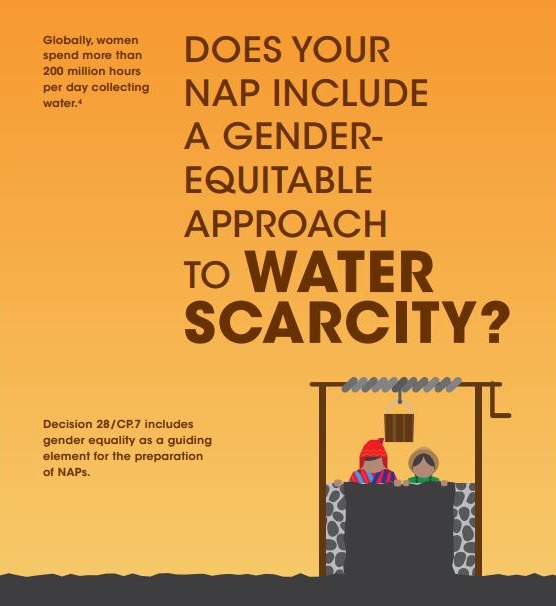Introduction
IUCN—International Union for Conservation of Nature—is the world’s oldest and largest international conservation organization that works in many sectors and many regions around the world. I am part of the gender team, or the Global Gender Office (GGO), of IUCN. This office focuses on mainstreaming gender considerations into environment and climate change work by providing innovative approaches, technical support, policy development, and capacity building to a wide range of partners. One of the key areas of concern for this office is promoting the inclusion of gender equality and women’s advancement in international climate change policies and programmes. To that end, we were entrenched in the process of preparing for and participating in the recent international climate change negotiations, the United Nations Framework Convention on Climate Change (UNFCCC) Conference of the Parties (COP) 20 held in Lima, Peru, in early December. As part of our campaign to promote gender equality and the advancement of women within the environmental sector, our office has committed to a strong communications and outreach plan, including launching a brand new website filled with information about our work, the importance of incorporating gender considerations into environment and climate change policies, and a resource library containing publications, policy reports, and factsheets published by IUCN and others in the field. Through the experiences of preparing for COP20 and developing our new website, I learned of the importance of teamwork, cooperation, and communications within a team.
Teamwork and Cooperation
The GGO is truly a team: valuing cooperation, communications, diverse perspectives, and innovation. I have learned a great deal about these competencies from this team which is based in Washington, D.C., but includes members based remotely in locations such as Costa Rica, Mexico, and Pennsylvania. Even those team members based in D.C. are often traveling throughout the world—and time zones! If we did not value teamwork and cooperation, we would be an unorganized group of people working towards separate goals. But as it is, we are a highly-functioning and caring team working together on various projects and programmes, always keeping in mind the priorities and goals of the GGO and IUCN. Two key examples of my experiences with the importance of teamwork and cooperation have been preparing for Gender Day at the UNFCCC COP20 and developing the content for our brand new website.
-
COP20 Preparations
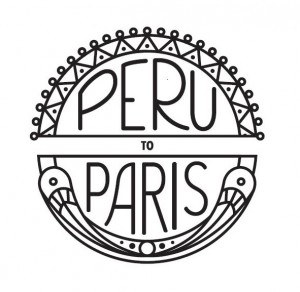
Credit: IUCN
UNFCCC celebrated Gender Day during COP20 on 9 December 2014. Throughout the day, events and negotiations focused on the importance of including gender considerations within this international climate change framework. GGO was involved in many aspects of the preparation and implementation of Gender Day, including the honor of hosting the closing event. This event, Advancing Gender Equality for Climate Action, was a delegates’ reception to celebrate the advancements of gender equality in the UNFCCC and inspire continued action toward a gender-responsive post-2015 agreement. Although I was not a member of IUCN’s delegation and did not have to opportunity to attend COP, I was part of the team preparing for this event.
A major aspect of this preparation involved developing our main messages and outreach strategy. We wanted to encourage delegates to actively consider all of the work that must, and can, be done within the next year to ensure a gender-responsive post-2015 framework. Therefore, this message was framed as Peru to Paris: A Challenge for Equality. A small team including the Senior Gender Adviser, Lorena Aguilar, and GGO Program Officer and Bard CEP alumnae, Margaux Granat, and myself developed our final messages. Once Lorena provided her initial thoughts, my task was to take the first pass at finding key statistics and developing powerful sound bites to highlight the importance of each. These messages contain a key fact or statistic, a relevant UNFCCC decision, and an overarching statement of importance. After many, many rounds of Margaux and I tweaking (and sometimes completely disregarding) our early ideas—with the assistance of two graduate students assisting our team for COP—we eventually finalized our messages! Working very closely with our excellent design team, based in Costa Rica, I cannot tell you how many times I read, re-read, and checked citations to ensure a meaningful product. We created a 12-month calendar and a notebook with these messages to promote delegates to consider these issues throughout the year and to go to Paris prepared to make a gender-responsive agreement. As I write this, I realize that it does not sound very glamorous. But, when I take a step back and realize that I am listed as an author on publications delivered to climate change negotiators encouraging them to thoughtfully consider the importance of gender issues, I am very proud of myself and this team.
Here are a few of my favorite messages:
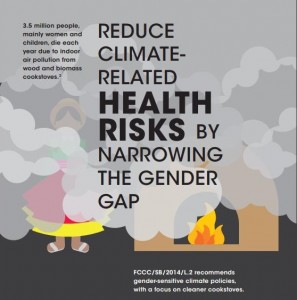
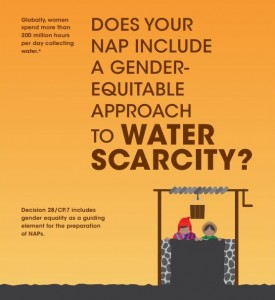
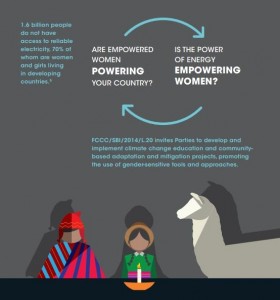
-
Development of a Brand-New Website
Part of our first-year coursework at Bard Center for Environmental Policy (Bard CEP) includes critically considering how best to communicate environmental and climate change issues to varying audiences. This is essential for our work at GGO because many people do not know about the relationship between gender and climate change. Our office hopes to act as a knowledge platform, sharing information with the global community, including practitioners, government ministries, non-governmental organizations, women’s organizations, and the general public. With such diverse audiences in mind, crafting our website content was challenging. We decided to have options available for viewers to read brief descriptions of our work, or to click for further information. Therefore, viewers can delve a bit deeper into topics that interest them without getting swamped with extra material. We also have a knowledge center; a resource library I will be continuously updating and expanding. Viewers can browse through IUCN publications or search through our database—containing IUCN and external publications, policy documents, and factsheets—by sector to learn more about the gendered aspects of a particular issue, such as forestry or disaster risk reduction. Our website was launched—due to a lot of teamwork and a bit of magic—on 9 December 2014, Gender Day. I hope you take a few minutes to browse through this site at genderandenvironment.org. I’d love to hear what you think!

